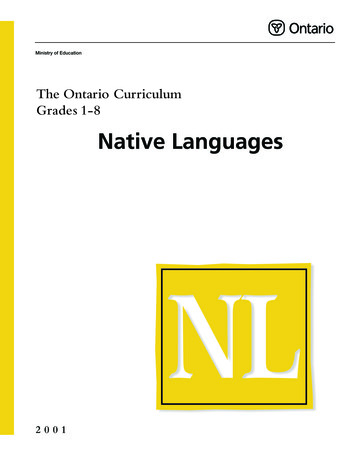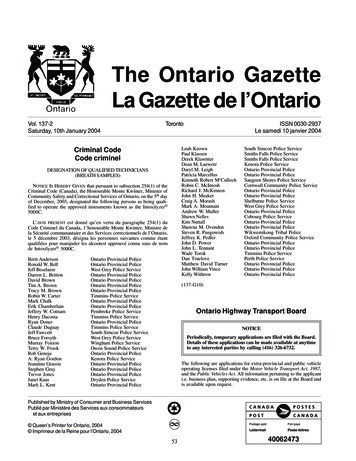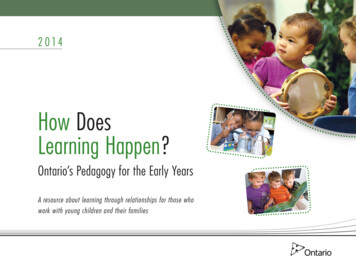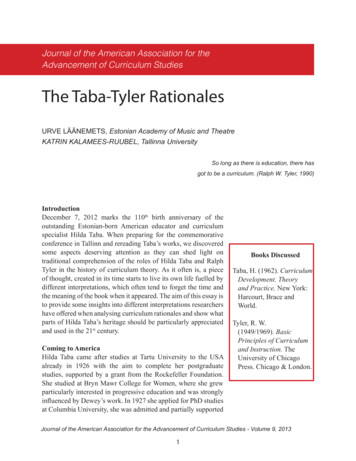
Transcription
Ministry of EducationThe Ontario CurriculumGrades 1-8Native Languages2001
ContentsIntroduction . . . . . . . . . . . . . . . . . . . . . . . . . . . . . . . . . . . . . . . . . . . . . . . . . . . . . . . .3Achievement Levels . . . . . . . . . . . . . . . . . . . . . . . . . . . . . . . . . . . . . . . . . . . . . . . . . . . 12Strands in the Native Language Curriculum . . . . . . . . . . . . . . . . . . . . . . . . . . . . . . . . . 14Curriculum Expectations for Grades 1 to 8 . . . . . . . . . . . . . . . . . . . . . . . . . . . . . . . . . . 17Explanatory Notes . . . . . . . . . . . . . . . . . . . . . . . . . . . . . . . . . . . . . . . . . . . . . . . . . . . . 37Une publication équivalente est disponible en français sous letitre suivant : Le curriculum de l’Ontario, de la 1re à la 8e année –Langues autochtones, 2001.This publication is available on the Ministry of Educationwebsite at http://www.edu.gov.on.ca.
IntroductionThe Native language program for Grades 1 to 8 has been designed to provide a dynamic andchallenging curriculum. It has been developed to provide: (a) a general understanding of thenature and function of language, which will serve as the basis for the development of Nativelanguage skills; (b) a foundation of language knowledge and skills in the Native languageunder study that will enable students to communicate in the Native language; and (c) anunderstanding and appreciation of the Native language as an expression of a distinctive culture.The ultimate goal of the Native language program is to inspire Native students with pride intheir ancestral language and to motivate them to use it to communicate in their daily lives – touse it, in other words, as a living language that is part of a living culture.The Place of Native Languages in the CurriculumLanguage carries within it the spirit, culture, history, and philosophy of a people; it revealshow they think and how they view the world. In short, language both defines and reflects theparticular attitudes and values of a people. Language, moreover, is the principal means bywhich culture is preserved and transmitted from one generation to another. First Nationcommunities are concerned that their languages and cultures are being lost; in some areas ofthe province, many of the younger generation can no longer speak or understand their ancestral language. The establishment of Native language programs in Ontario schools is thereforean important step towards reclaiming and revitalizing Native languages.Although no study has as yet been undertaken to assess the long-term effects of Native students’exposure to their languages and cultures, a link has been established between students’ selfimage and their success as learners. Since the study of their own language and culture willstrengthen Native students’ sense of self, both as individuals and as members of a culture withdistinctive and relevant traditions, there is every reason to expect that Native students enrolledin Native language courses will be better motivated to learn and to put the kind of effort intotheir school work that leads to success.The Native language program in elementary schools in Ontario is not intended exclusively forNative students from First Nation communities. The program is open to all Native and nonNative students who want to learn a Native language and develop a better understanding ofthe culture of which that language forms part. Non-Native students enrolled in Native language programs will enjoy the benefits of cross-cultural education. By learning about a culturethat is different from their own, they will both expand and enrich their view of the world andgain a better understanding of their own culture. At the same time, they will develop a deeperappreciation of and respect for the identity, rights, and values of others.4
The Purpose of The Ontario Curriculum, Grades 1–8: Native Languages, 2001This document sets out the minimum expectations that students enrolled in Native languageprograms are required to achieve in each grade from Grade 1 to Grade 8. It also provides a listof language elements for each grade. The language elements introduced in one grade arebroadened or reinforced in subsequent years, thus permitting a steady growth of knowledgeand skills from grade to grade.This document supersedes Native Languages, Part A: Policy and Program Considerations; Primary,Junior, Intermediate, and Senior Divisions, 1987. All Native language programs in Grades 1 to 8will be based on the curriculum expectations outlined in this document.Policies Relating to Native Language ProgramsAccording to current policy pertaining to elementary school Core French (FSL), all studentsentering Grade 4 must receive French instruction in every year from Grade 4 to Grade 8.However, policy pertaining to the relationship between FSL and Native language programsstates that students are to be exempted from the FSL program if their parents1 decide, afterconsultation with the principal, that it is in their best interests not to receive French instruction. In elementary schools where the parents or guardians want their children to participatein both a Native language program and an FSL program, principals will have to make arrangements to accommodate both language programs.The Native language program comprises expectations that students are to achieve in eachgrade from Grade 1 to Grade 8. However, school boards may choose to design their programsin such a way that students can enter them in Grade 4 rather than Grade 1. Boards that chooseto start their programs at Grade 4 must ensure that students are given the opportunity toachieve all of the expectations outlined in this document by Grade 8.All Native language programs are to be offered during the school day. A minimum of 20 minutes should be allocated to the program per day in Grades 1, 2, and 3, and 40 minutes shouldbe allocated per day in Grades 4 to 8.When a school board decides to offer a Native language program at the elementary level, itshould take into account that the program must be offered through to the end of secondaryschool.The Native language program may be offered in any of the following languages: Cayuga,Cree, Delaware, Mohawk, Ojibwe, Oji-Cree, and Oneida.The Aims of the Native Language ProgramThe principal aims of the Native language program – the development of language skills andthe development of cultural awareness – are inseparable. Cultures vary in the way they viewdifferent aspects of life as well as in the ways in which they express ideas and feelings aboutthese aspects of life. Learning a language, therefore, involves discovering a culture’s distinctiveforms of expression. The Native language program develops an understanding of the nature oflanguage, basic communication skills in Native languages, and an appreciation of Native cultures in Canada and the rest of North America.1. The word parents, as used in this document, includes both parent(s) and guardian(s).5THE ONTARIO CURRICULUM, GRADES 1–8: NATIVE LANGUAGES, 2001
The Native language program is not designed to make students fully bilingual; rather, the program offers students the opportunity to develop a basic command of a Native language that canbe expanded through further study or through contact with other speakers of the language.The program allows students to develop their language skills and improve their use of language through study, practice, and communication. Students are given learning opportunitiesthat will allow them to develop their language skills in all three areas of language use – oralcommunication, reading, and writing. Students will thus have opportunities to listen to variousforms of oral communication and to understand ideas and concepts expressed in the Nativelanguage under study; to talk about their experiences and to express their thoughts and feelingswith clarity and confidence; to read written materials in the Native language, including itsliterature, with growing proficiency; and to write in the Native language using a Nativelanguage writing system.2 In addition, students will become familiar with the traditions, customs, social structures, history, and arts of the pertinent Native culture. Activities that willallow students to link their classroom experiences with life in their community and in othercommunities through electronic technology will also be emphasized.The elementary curriculum for Native language programs is designed to prepare students forsuccess in Native language programs at the secondary level.3 The expectations that form thebasis of the secondary school curriculum build on the knowledge and skills that studentsacquire in their elementary programs.Curriculum Expectations and Achievement LevelsThe Ontario curriculum for Native language programs comprises two elements: curriculumexpectations and achievement levels. The expectations identified for each grade describe theknowledge and skills that students are expected to develop and to demonstrate in their classwork, on tests, and in various other activities on which their achievement is assessed. Theachievement levels are to be used in assessing students’ achievement of the expectations.Two sets of expectations are listed for each grade. The overall expectations describe in generalterms the knowledge and skills that students are expected to achieve in all strands, or broadcurriculum areas, by the end of each grade. The specific expectations describe the expectedknowledge and skills in greater detail. Since the overall expectations describe knowledge andskills that are fundamental to the Native language program as a whole, they sometimes remainthe same from grade to grade or are only slightly modified to indicate a higher level of difficulty.The sequential progression from grade to grade is more evident in the specific expectations,which describe the knowledge and skills expected at particular stages in more specific terms.The specific expectations are organized into three strands, which correspond to the three mainareas of language use: oral communication, which includes listening and speaking; reading;and writing. This organization is not meant to imply that the expectations in one strand areachieved independently of the expectations in the other strands.2. Roman orthographies have been developed for all Native languages in Ontario. However, a syllabic writing system isstill used in many northern communities by speakers of Cree and Ojibwe. It is the responsibility of each First Nationcommunity to determine the orthography that will be used in the local Native language program.3. Students who have completed a Native language program at the elementary level will be prepared to enter the Level 2Native language course (NL2) in secondary school.INTRODUCTION6
Many of the expectations are accompanied by examples, given in parentheses. These examplesare meant to illustrate the kind of skill, the specific area of learning, the depth of learning,and/or the level of complexity that the expectation entails. They are intended as a guide forteachers rather than as an exhaustive or mandatory list.The achievement levels are brief descriptions of four different degrees of achievement of theprovincial curriculum expectations for any given grade. These descriptions will be used byteachers to assess students’ learning. (Letter grades and percentage marks will be used to reportstudent achievement on the report card.) The achievement levels for Native language programs focus on knowledge and skills in five categories: communication, listening and readingcomprehension, organization of ideas, application of language knowledge (grammar, vocabulary, and spelling), and knowledge and understanding of culture. When teachers use theachievement levels in reporting to parents and speaking with students, they can discuss what isrequired of students to achieve the expectations set for their grade. Level 3, which is the“provincial standard”, identifies a high level of achievement of the provincial expectations.Parents of students achieving at level 3 in a particular grade can be confident that their childrenwill be prepared for work in the next grade. Level 1 identifies achievement that falls muchbelow the provincial standard. Level 2 identifies achievement that approaches the standard.Level 4 identifies achievement that exceeds the standard. It should be noted that achievementat level 4 does not mean that the student has achieved expectations beyond those specified fora particular grade; it indicates that the student demonstrates a greater command of therequired knowledge and skills than a student achieving at level 3.Planning Student ProgramsThe Native language curriculum emphasizes the development of language skills through oralcommunication, particularly in the early grades. In Grades 1 to 3, teachers should plan theirprograms so that classroom instruction centres on listening and speaking skills. In Grades 4 to 8,all four language skills will be developed, and an increasing amount of time will be spent onreading and writing. Oral communication, however, should remain an important focus throughall grades. (The accompanying chart illustrates an appropriate allocation of time to the threestrands of the program over the course of eight grades.) Learning activities must include anappropriate balance of the skills of oral communication, reading, and writing in each grade,and the evaluation of student achievement must reflect the emphasis in the curriculum on thedevelopment of oral communication skills.Approximate Allocation of Class Time to the Three Strandsin Native Language ProgramsGrade 1Grades 2–3Grades 4–80%20%Oral Communication –Listening740%Oral Communication –Speaking60%80%Reading100%WritingTHE ONTARIO CURRICULUM, GRADES 1–8: NATIVE LANGUAGES, 2001
Special attention is given in the curriculum to the Native oral tradition. With the help ofNative speakers from the community, teachers should plan learning experiences that will allowstudents to listen to and retell traditional Native stories, legends, and histories, and to singtraditional songs. Aspects of Native culture and philosophy should be integrated in languagelearning activities throughout the grades so that students may have opportunities to see Nativeculture and values as an integral part of the language they are studying.Because of its focus on oral communication, the Native language program may be deliveredmost successfully through the use of the communicative method of language teaching, whichaims to teach language in a way that allows learners to use it in everyday life. This approachfocuses on the communicative aspect of language and emphasizes the use of language in theclassroom in relevant contexts and for relevant purposes. The Native language should thereforebe the language of communication in the language class. Normal interaction in the classroomwill provide students with natural opportunities to speak in the Native language and to hearthe Native language spoken. It will also give them opportunities to use the vocabulary andlanguage structures they are taught in a variety of purposeful contexts, and to apply what theyhave learned in order to express what they want to say.Effective communication depends on accuracy and clarity of expression. Therefore, grammaticalaccuracy is emphasized in the new Native language curriculum, and it is expected that correctform will be taught and practised in the classroom.Native language programs should aim to develop language skills in contexts that students willsee as useful and relevant. The programs should be designed so that elements from the othercurriculum areas are integrated into the language program. An integrated language programwill help students to see connections and relationships among ideas, people, and things, and torelate their learning not only to other subjects but also to the world outside the school.Native-language teachers should provide activities and assignments that are interesting andmeaningful to students. Interviews, oral presentations, dramatizations and simulations, dialogues,and cooperative games are examples of effective communication activities. Frequent opportunities to interact with Native speakers will not only reinforce the relevance of language learningfor students, but will also allow them to develop an awareness of the richness and idiosyncrasiesof the language and to appreciate its subtleties. Students should also have numerous opportunities to interact with one another both on a one-to-one basis and in small- and large-groupactivities. Whenever possible, students should also take advantage of the resources of electronictechnology in developing the four language skills.Elders, parents, and other community members can play an important role as classroom resources.For example, they can provide valuable input in selecting the dialect and orthography to beused in the program. The Native language program offers many opportunities for maintainingcontinuity between the classroom and the family, and between the classroom and communityactivities.Adapting Program Elements to the Native Language Under StudyThere are two Native language families in Ontario, the Algonquian and the Iroquoian. TheAlgonquian language family includes Cree, Delaware, Odawa, Ojibwe, Oji-Cree, and Potawatomi.The Iroquoian language family includes Cayuga, Mohawk, Oneida, Onondaga, Seneca, andTuscarora. These languages are as complex and varied as English or French in terms of theirgrammatical and lexical structures, and as rich in their range of styles and functions.INTRODUCTION8
The differences between the two language families are not only great but fundamental. (AnAlgonquian language is a “foreign” language to a person who speaks an Iroquoian language,and vice versa.) For this reason, the lists of language elements and examples in the “Grammar,Language Conventions, and Vocabulary” sections of the various grades (see “CurriculumExpectations for Grades 1 to 8”) are given in English. Each Native-language teacher will haveto select the language elements that apply to the language under study and make whateveradjustments are necessary to make them relevant. In addition, the members of each First Nationcommunity who speak the language will have to determine the dialect and orthography thatwill be used in the local Native language program.Native Language Programs for Exceptional StudentsRecognizing the needs of exceptional students and providing appropriate programs and services for them are important aspects of planning and implementing the curriculum. A regulation made under the Education Act requires that school boards establish a committee, called anIdentification, Placement, and Review Committee (IPRC), to identify and place exceptionalstudents. When an IPRC identifies a student as exceptional, it must, in its statement of decision, provide a description of the student’s strengths and needs and a decision on appropriateplacement for the student. The IPRC can also make recommendations for suitable educationprograms and services.When an IPRC identifies a student as exceptional, an Individual Education Plan (IEP) mustbe developed and maintained for that student. (It should be noted that an IEP may also beprepared for students with special needs who are receiving special education programs and/orservices but who have not been identified as exceptional by an IPRC). An IEP describes thestudent’s educational program, which is based on and modified by the results of continuousassessment and evaluation. It identifies the student’s specific learning expectations and explainshow the school will address these expectations (for example, through appropriate programsand services, modifications in the regular program, and other accommodations). It also identifies the methods by which the student’s progress will be reviewed.In developing the student’s IEP, consideration must be given to any recommendations made bythe IPRC concerning programs and services that may be particularly appropriate for meetingthe student’s needs. Also, the school must consult with the parents of the student at the development stage. The IPRC’s recommendations and the results of consultation between the parentsand the school staff will form the basis of decisions concerning the ways in which the learningexpectations set out in the provincial curriculum will be modified to meet the student’s specialneeds. Once the IEP has been developed, the parents of the student must be provided witha copy.Those involved in developing the IEP should work together on an ongoing basis to reviewthe student’s progress and make adjustments to the IEP as necessary. It is important that theschool continue to keep parents informed about the program and the progress of the student,as parents can provide valuable support for their child’s learning.In planning programs for exceptional students, teachers must take into account the students’strengths and needs, learning expectations, accommodations, and methods for reviewingprogress as outlined in the IEP. It is important that teachers provide appropriate instruction,9THE ONTARIO CURRICULUM, GRADES 1–8: NATIVE LANGUAGES, 2001
activities, and assignments, as well as resources, strategies, and settings that will help exceptionalstudents achieve their learning expectations. Using the most appropriate methods and providing the most appropriate materials may involve making changes in the teaching approaches(e.g., styles of presentation, methods of organization, use of technology and multimedia) andthe curriculum content (e.g., amount of material covered, type of material used) that are normally used for most other students. Changes may also need to be made in some assessmentand evaluation procedures. For example, exceptional students may need to be given additionaltime to complete assignments or tests; they may need to do tests orally or in forms that combine a variety of methods and media; and they may need more guidance regarding what isexpected in a particular assignment or test than would normally be given.The Role of StudentsStudents have responsibilities with respect to their learning, which increase as they advancethrough elementary and secondary school. Students who are willing to make the effortrequired and who are able to apply themselves will soon learn that there is a direct relationshipbetween achievement and hard work, and will be motivated to work as a result. There will besome students, however, who will find it more difficult to take responsibility for their learningbecause of special challenges they face. For these students, the attention, patience, and encouragement of Native-language teachers can be extremely important factors for success. However,regardless of their circumstances, learning to take responsibility for their progress and achievement is an important part of education for all students.The Role of ParentsStudies have shown that students perform better in school if their parents are involved in theireducation. Even if they do not speak or understand a Native language, parents still have animportant role to play in supporting their children’s learning of the language, as well as theirschool attendance and academic performance. By familiarizing themselves with the curriculum,parents will be able to discuss their children’s work with them and with their Native-languageteacher. Knowledge of the overall and specific expectations in the various grades will also helpparents to understand how students’ work is evaluated, to interpret their children’s report cards,and to work with the teacher to improve their children’s learning and academic performance.Parents can also demonstrate their interest in their children’s education in many other ways;participating in parent-teacher conferences, working on or with the school council, andencouraging their children to complete assignments at home are three obvious examples. In thecase of Native language programs, it is particularly important for parents to reinforce the valueof the Native language and culture.The Role of Native-Language TeachersNative-language teachers must make every attempt to motivate students to learn a Native language by providing a supportive and stimulating environment for language learning. Languageskills should be introduced and practised in contexts that are both relevant and interesting forthe students so that they can see the value of what they are learning.INTRODUCTION10
Teachers should select the teaching and learning strategies that will best promote studentlearning of the Native language under study. These may include student-directed activities andmultidisciplinary strategies, in which language learning is related to other subject areas, such asgeography and history. Whatever the methods and strategies used, teaching in a Native language program must take into account the needs of the students, the learning styles of individual students, and the resources available. It must also focus on the importance of buildingstrong personal values and positive attitudes both towards the Native language and towardslearning in general. Language learning activities that are based on students’ interests, needs, anddesire to communicate will achieve the best results in the Native language classroom.It is also necessary for Native-language teachers to work with the principal of the school andthe First Nation community in choosing the dialect and orthography for the program, inconducting the ongoing review of the program, and in developing long-range plans for theprogram. Native-language teachers should consult parents and other teachers in the schoolabout the background and needs of students in Native language classes. It is also importantfor Native-language teachers to take part in special language-related school events, such asLanguage Week.The Role of the PrincipalThe principal has a significant role in the development, implementation, and evaluation of theNative language program of the school, and can contribute to its success in various ways. Heor she can encourage second-language teachers – Native-language and FSL teachers – to worktogether in developing language-teaching materials and to share language-related resources.The principal can also encourage Native-language teachers to work with classroom teachersto integrate Native language instruction and learning in other areas of the curriculum. It is theresponsibility of the principal to provide assistance and advice to Native-language teachers andto encourage them to participate in professional development activities that focus on Nativelanguage programs and their delivery.The principal should take a leading role in promoting the Native language program. Forexample, he or she can initiate or take part in organizing special school-wide events that focuson the use of the Native language or aspects of Native culture; encourage the First Nationcommunity to support the Native language program and to assist in making decisions about itsdesign and goals; and encourage both parents and knowledgeable members of the communityto participate in the program as classroom resources. The principal should also maintain effectiveliaison with the First Nation community and keep parents informed about the effectiveness ofthe program.The Role of the CommunityThe success of Native language programs depends on the involvement of community membersat the local level and the overall support of First Nation communities. Often Native-languageteachers and fluent speakers of the language in the community are the only advocates ofNative language programs. It is essential that Native-language teachers and all those involvedin the development of Native language programs do all they can to ensure that this supportbase is broadened. If First Nation communities do not play an active part in promoting andsupporting the teaching of Native languages in schools, the cultures of Native peoples – thetraditions, values, beliefs, and unique world view inherent in Native languages – may very wellbecome extinct. It is particularly important that parents and members of the local communityreinforce the value of the Native language and culture.11THE ONTARIO CURRICULUM, GRADES 1–8: NATIVE LANGUAGES, 2001
If the Native language program is to be effective and relevant for the students of the community, it is essential that First Nation community members agree about certain basic aspects ofthe program. Therefore, it is of the utmost importance that speakers of Native languages beinvolved in local policy decisions regarding dialect and orthography. Local Native organizations other than schools need to recognize and endorse the efforts of students to revitalizeNative languages. For example, local Native newspapers could keep the issue of language inthe forefront by reporting on student activities in Native language programs. Local radio stationscould provide programs that focus on the vocabulary or other aspects of a Native language.Stations using the Native language could broadcast songs, chants, and stories that can be learnedby listeners. Local band administration offices could play a leadership role for the communityby officially adopting the Native languages for administrative purposes and the conduct ofdaily business in the community, including road and public building signage, and communitynotices. Organizers of public functions in the community could include a Native languageportion in the program to demonstrate that Native languages are valued. Members of thecommunity can support the Native language program by acting as resource persons in a varietyof ways; for example, they can offer to speak to students about cultural traditions, tell storiesthat reveal Native values, and answer students’ questions about a variety of topics.INTRODUCTION12
Achievement LevelsThe achievement chart that fo
these aspects of life. Learning a language,therefore,involves discovering a culture’s distinctive forms of expression.The Native language program develops an understanding of the nature of language,basic communication skills in Native languages,and an appreciation of Nat










